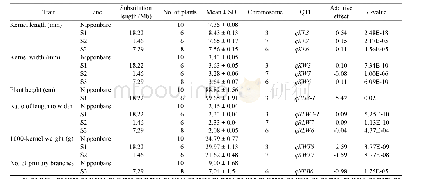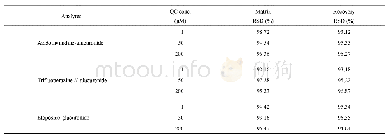《Table 3.Additive effect analysis of QTLs in three single-segment substitution lines S1,S2 and S3.》下
 提示:宽带有限、当前游客访问压缩模式
提示:宽带有限、当前游客访问压缩模式
本系列图表出处文件名:随高清版一同展现
《Identification of Rice QTLs for Important Agronomic Traits with Long-Kernel CSSL-Z741 and Three SSSLs》
Three SSSLs(S1,S2 and S3)were developed by markerassisted selection(Table 3).The QTLs were then validated by the t-test based on comparison of the measured traits of Nipponbare for each SSSL,because there is only one segment differed between them.Among the 20 QTLs detected in 2018,8 QTLs(qKL3,qKL7,qRLW3-1,qRLW7,qPH3-1,q KWT3,qKWT7and qNPB6)were repeatedly detected in 2019,indicating that these QTLs were genetically stable.The additive effects of q KL3 and qKL7 increased the kernel length by 0.54 and 0.15 mm,respectively,in 2019.Accordingly,S1,S2 and S3 had longer kernels than Nipponbare(Fig.2).Three QTLs(qNPB3,qNPB7 and qPL3)with additive effects of 8.42%,4.80%and 5.52%,respectively,in 2018(Table 2),were not detected by examination of the SSSLs in 2019,indicating that some minor QTLs are susceptible to environment.In addition,five QTLs can be detected on S1,S2 and S3,which were not detected in the Nipponbare/Z741 F2 population.q KL6increased the kernel length by 0.11 mm,qKW3 and qKW6 increased kernel width by 0.10 and 0.11 mm,respectively,whereas qKW7 and q RLW6 reduced grain width and ratio of length to width by 0.08 mm and0.04,respectively,in 2019(Table 3).
| 图表编号 | XD00153918900 严禁用于非法目的 |
|---|---|
| 绘制时间 | 2020.09.28 |
| 作者 | WANG Hui、ZHANG Jiayu、Naz FARKHANDA、LI Juan、SUN Shuangfei、HE Guanghua、ZHANG Ting、LING Yinghua、ZHAO Fangming |
| 绘制单位 | Rice Research Institute、College of Agronomy and Biotechnology, Southwest University、Rice Research Institute、College of Agronomy and Biotechnology, Southwest University、Rice Research Institute、College of Agronomy and Biotechnology, Southwest University、Ric |
| 更多格式 | 高清、无水印(增值服务) |
查看“Table 3.Additive effect analysis of QTLs in three single-segment substitution lines S1,S2 and S3.”的人还看了
-

- Table 4 Variance analysis and significance test of seedling growth of three different substrate nutrient bags of Sarcand
-

- Tab.1 Effects of three drugs on RVHI in the high altitude sickness of rats with hypoxia deacclimatization±s, n=10)
-

- Tab.3 Effects of three drugs on left ventricular function in the high altitude sickness of rats with hypoxia deacclimati





